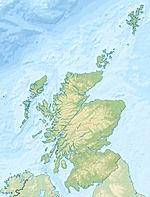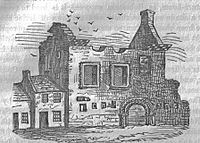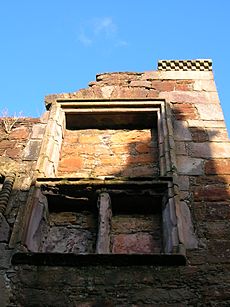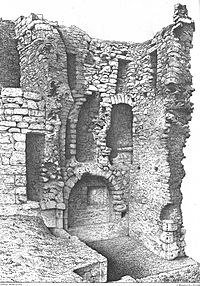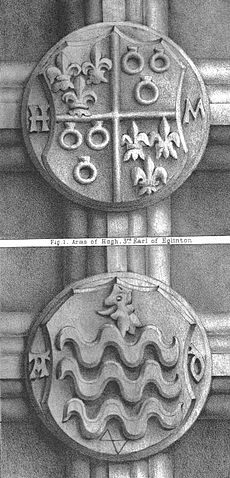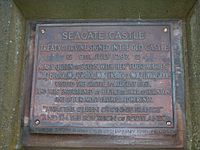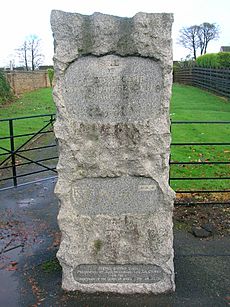Seagate Castle facts for kids
Quick facts for kids Seagate Castle |
|
|---|---|
| Irvine, North Ayrshire, Scotland UK |
|

The castle entrance
|
|
| Coordinates | 55°37′00″N 4°40′14″W / 55.616804°N 4.670483°W |
| Site information | |
| Owner | Historic Scotland |
| Controlled by | Montgomery Clan |
| Open to the public |
On special occasions |
| Condition | Ruin |
| Site history | |
| Built | Sixteenth century |
| Materials | Stone |
Seagate Castle is an old castle found in Irvine, a town in North Ayrshire, Scotland. It's located very close to the River Irvine. This castle was once a strong fort, a fancy town house, and later a special home for widowed noblewomen of the Montgomery family.
The castle looks over the oldest street in Irvine. This street used to be the main path between the town and the old harbour at Seagatefoot. By 1606, this harbour was no longer useful because too much sand had built up. Today, the castle's remains are protected as a scheduled ancient monument, meaning it's an important historical site.
Contents
History of Seagate Castle
Irvine: A Royal Town
The town of Irvine was first mentioned in records in 1163. Back then, its harbour was near the area called Seagate, which is why the castle was first built to protect it. Over time, many writers noted that sand blown by the wind made it hard for ships to move, sometimes trapping them for months.
Irvine became a "Royal Burgh" in 1372, given this special status by King Robert II. This meant it was a town with special rights from the king. Seagate Castle is the only old building left from Irvine's early days. Other important buildings like the Carmelite friary, the old town hall, a chapel, a bridge, and the original port have all disappeared.
The Castle's Story
Records from 1184 mention a castle in "Hirun," which is thought to be Irvine. This means the first castle, likely made of wood, was built before 1184. It was rebuilt with stone around the 1360s. Then, around 1565, Hugh, the 3rd Earl of Eglinton, updated and made it bigger.
In the 1100s, Irvine Castle was part of the Cunninghame area, which King David I had given to Hugh de Morville. Later, the land passed through different families, including the Balliols. Eventually, Robert the Bruce gave the land to Robert the Steward.
In 1366, the castle came into the hands of Sir Hugh de Eglintoun. He also became the manager of Irvine and the Cuninghame area. Sir Hugh married Egidia, the half-sister of Robert the Steward (who later became King Robert II). They had one child, Elizabeth. Elizabeth de Eglintoun was the only heir, and when she married John Montgomerie, the castle and other lands became part of the Montgomerie family's possessions.
Seagate Castle, likely the third castle built in Irvine, isn't a typical town house. It has features of a strong castle, but it was built more like a grand palace or mansion between 1562 and 1585. Some people believe it includes parts of the very old 12th-century castle of "Irewin," which was described as a strong fort in 1184. However, this hasn't been proven. The triangular tower in the north-west corner might be from this earlier castle.
In 1945, Seagate Castle was given to the town of Irvine by Mrs. Walker of Castlepark. In 1992, a small dig was done to find the medieval castle. They found old layers of dirt and a short wall, but couldn't figure out its exact age.
Castle Keepers
Seagate Castle had a "Constable," who was like a manager, looking after it for the lord. Records show different people held this job over the years. This role ended in 1596.
Castle Design
The castle's entrance doorway is in a Scottish Renaissance Gothic style, which was popular in the 1500s. The building looks more like an elegant mansion than a defensive fort, with fancy windows and decorations. You enter through a vaulted archway that goes through the front part of the castle. This archway leads to a courtyard and has a beautiful arched doorway, similar to one at Linlithgow Palace.
The main part of the castle faces the street. To the east, there were three towers: two round ones and one triangular. Some think the triangular tower is much older. There might have been a small guardroom and a prison pit in this area.
The southern part of the main building and one round tower are now just foundations. But the rest of the castle walls are still quite complete. The ground floor has vaulted rooms, including two guard rooms, each with one door for defense. The kitchen and its fireplace are still there, as are two main rooms to the south. One of these rooms was the only one connected to the upper floor by a private staircase, leading to what was probably the great hall. The kitchen has a large arch, a big window, and cupboards, plus a serving hatch. The upper floors, with their fireplaces and nice windows, were reached by a round tower from the courtyard.
The fancy entrance off Seagate Street has caused some discussion. It looks more like a church entrance than a castle one. Some say it's "Saxon" or "Norman," but others believe it's typical Scottish Renaissance Gothic work from the 1500s and 1600s. At that time, Kilwinning Abbey was being taken apart, so stones from there might have been used to build this doorway and other parts of Seagate Castle.
There was a drain for waste conveniently located outside the kitchen's back door in the courtyard, with channels from upstairs toilets. Many different "mason's marks" (symbols carved by the stoneworkers) can be seen on the stones. The building might have been covered in a rough plaster called "harled."
Smugglers and Damage
Around 1746, the castle's roof was removed, and it was no longer lived in by the family's staff. Instead, Seagate Castle became a hiding place for smugglers, thieves, and beggars. Locals avoided it after dark. If anything was stolen in town, the castle was the first place people searched. In the 1800s, older people could still remember seeing smugglers' small illegal alcohol stills in the large kitchen fireplace.
People from the area also took stones from the castle to use for their own buildings. However, in 1810, Earl Hugh (the 12th Earl) made many repairs, blocking up windows and doors. In 1839, a big storm caused a lot of stones to fall into the courtyard. When the castle was checked in 1883, the rooms were full of rubble and trash. The Earl of Eglinton had it all removed, which took about a month.
In 2010, even though the castle was still a roofless ruin, it still showed how important it once was as a town house. The local council carried out some repair work in the 1970s and 1990s to keep the structure safe.
The Montgomerie Family
The Montgomerie family probably built the castle as their town home and as a "jointure house" – a home for the widowed countesses of the family. The coat of arms (family symbol) of one owner, likely the builder Hugh Montgomerie, 3rd Earl of Eglinton, can be seen in the entrance archway. His initials 'HM' are there, along with the arms and initials 'AD' of his wife, Agnes Drummond. He married her in 1562 and died in 1585.
Over the centuries, other homes like Kilmaurs House and Auchans Castle were also used by the family as homes for widowed noblewomen.
Castle Abandonment
Seagate Castle was lived in until about 1746. That's when Alexander Montgomerie, 10th Earl of Eglinton (1723–1769) had its roof removed. The wood from the roof was used to help build a new church in Ardrossan. A traveler named Pocoke visited Irvine in 1760 and described the castle as already being a ruin.
Mary Queen of Scots and Marymass

A plaque at the castle entrance says that Mary, Queen of Scots, stayed at the castle in 1563. The 3rd Earl of Eglinton was a big supporter of the Queen. It's said he hosted her and her four ladies-in-waiting (all named Mary: Mary Seton, Mary Beaton, Mary Fleming, and Mary Livingston) at the castle.
Some people believe this visit is why Irvine has its annual Marymass celebrations in August. However, it's more likely that Marymass comes from the town's church being dedicated to the Virgin Mary, whose festival of Assumption is on August 15th. Another idea is that the festival was named after Lady Mary of Eglinton, from the family crest, who supposedly fought off a Viking.
In the 1880s, during the Marymass Fair, groups like the carters and freemasons would return from the parade and stop in front of the old castle to sing "Auld Lang Syne." The carters still continue this tradition today.
Treaty of Irvine
The castle's information plaque also mentions that the "Treaty of Irvine" between Scotland and England was signed at Seagate Castle on July 9, 1297. This would have happened in the earlier castle that stood here.
In 1297, King Edward I sent an army led by Sir Henry Percy to Irvine. Their goal was to stop a Scottish uprising against Edward, who had removed John Balliol from the Scottish throne. The Scottish army was led by Robert Bruce (who later became King), Bishop Wishart, and others. However, after much discussion, they decided to surrender without a fight.
The two armies were camped where they could see each other: the English at Tarryholme and the Scots at Knadgerhill, with an old loch (lake) between them. Rodolph de Eglinton is said to have hosted the talks at Seagate Castle. Robert the Bruce never fully accepted the surrender terms, and King Edward I didn't confirm the treaty.
Over time, stories about this event became more dramatic, even including a made-up brave action by William Wallace here. The original treaty still exists in London. Through this treaty, some Scottish leaders agreed to submit to the English. This treaty is also known as the "Capitulation of Irvine."
Major General Robert Montgomerie
Robert Montgomerie was a son of the sixth Earl and lived in Irvine, probably at the Seagate Castle townhouse. In 1682, a strange case involving witchcraft happened in his home. An Irish maid was accused of stealing silverware. She said she was innocent and angrily offered to call upon the Devil to find the real thief. No one took her seriously, but she went into the cellar, drew a circle, and performed a ritual. She claimed she conjured the Devil and found out where the silverware was hidden.
The silverware was found, but the General reported her to the authorities, and she was put in the Irvine jail. She admitted learning the ritual from a doctor in Ireland. Her final fate is not known. During the ritual, the general and his wife felt a strange terror, and the town's dogs barked in fear.
Images for kids
Quick Facts
- In 2010, Seagate Castle was in danger of partly collapsing. In 2011, the local council carried out repairs to make it safe.
- George Gemmell, a supporter of the king, is said to have lived at Seagate Castle in the 1600s.
- The Earls of Eglinton also had another house in Irvine called Castlepark.
- Some local legends say that secret tunnels run from Seagate Castle to Stanecastle and to Dundonald Castle.
- In 1859, crowds celebrating Robert Burns' 100th birthday sang 'Auld Lang Syne' outside the castle walls.


